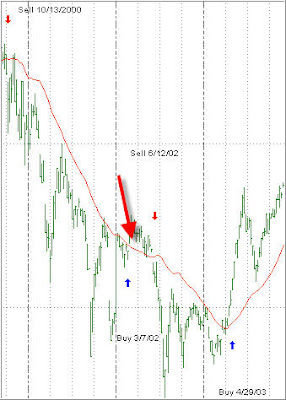One reader pointed to a CNBC video featuring a short presentation about a “flattening trend line.” Take a look but disregard the useless chatter afterwards:
While I don’t use the 150-day moving average as shown in this demonstration, this nevertheless poses an interesting question. Does entering the market (using our entry rules), after the trend line of the Trend Tracking Index (TTI) has flattened, enhance the chances of success?
In other words, are the odds of the price trend continuing to the upside greater when a trend line has flattened as opposed to getting a buy signal while it is still falling?
To find an answer, I had to look back to the last bear market of 2000, where our sell signal kept us out of domestic equities from 10/13/2000 until 4/29/2003.
However, that time frame was interrupted by a short whip-saw period (which was long enough to result in a profit) from 3/7/02 until 6/12/02. Take a look at that enlarged portion of the chart:

As you can clearly see, the trend line (red) was still descending as the ‘Buy’ on 3/7/02 was generated. At the moment the ‘Sell’ was triggered on 6/12/02, it had actually turned up slightly.
Since this is the only example I could find, it certainly is not conclusive to say that buy signals, while the trend line is still descending, will always lead to whip saws.
To gain more insight, let’s look at the opposite tomorrow: The effect of selling when the trend line is still rising. Maybe that will lead us to a better conclusion.

Comments 5
Ulli,
If you look back over the years using this flattening 150 day thing one would be so confused because sometimes it makes several of those flat spots before a bottom is actually put in place. It all sounds so easy, but believe me it isn’t the Holy Grail of timing the market.
T.M.
Hi,
All market gurus, letter writers etc. make their programs sound so inviting and sound so successful, but further investigation many times proves otherwise. These same people put out all this stuff like the 150 day moving avg. flattening thing and it can lead one to poverty following such a thing.
Ulli,
With regards to the flattening of the 150 day m.a. to call a bottom and unless I missed something they never said if that was supposed to work for market tops. I looked at a long term chart of the SPX (SP500) and these are the approx. periods where the lines flatten and they would have been of little value for finding bottoms or tops. Nov 1998 Oct 1999 Feb 2000 Aug 2000 Oct 2000 Nov 2001 April 2002 Feb 2003 April 2003 Oct 2004 Oct 2005 July 2006 Aug 2007 Nov 2007. These may not be exact points on the chart, but are close and get the point across.
The guy on the video was not some letter writer. He was chief mkt technician for Oppeinheimer who runs 100s of millions or billions based on his metrics. He called a Nov bottom which wud not go more then 10% below that well before March. Much of the comments in this setting are inane praddle.
On another item, from the freebee charts msn.com on its custom period easily shows (using their 200 day ma) that in 1970, 1979, 1982, 1984 and 1988 where the ma started to flatten was the point where the mkt ascended for a significant period of time. Something to ponder.
A final aside, Ulli, many of those that call recoveries for a living “”pronosticate”” that indeed with the woestate of the American economy that this recovery may be ‘L’ shaped far longer then any of us wud like to consider. Has yur investment service while using trend following ever faced similar where mkt rise may be meager at best for a prolonged period. What do yu/trend following advise for those of us that do not have extended long horizons for the active period of investing. Have yu give considerations for this type of mkt for similar clients
Anon,
It does not really matter if future market rises are meager or not. What matters is that you stick to an investment discipline on the entry side as well as on the exit side. That way, you will always participate in upswings that may turn out to be better than meager.
Ulli…